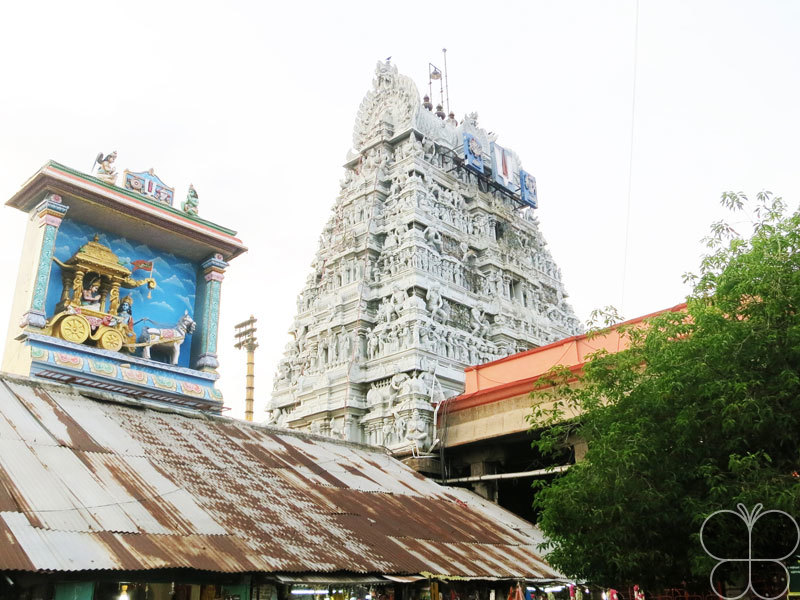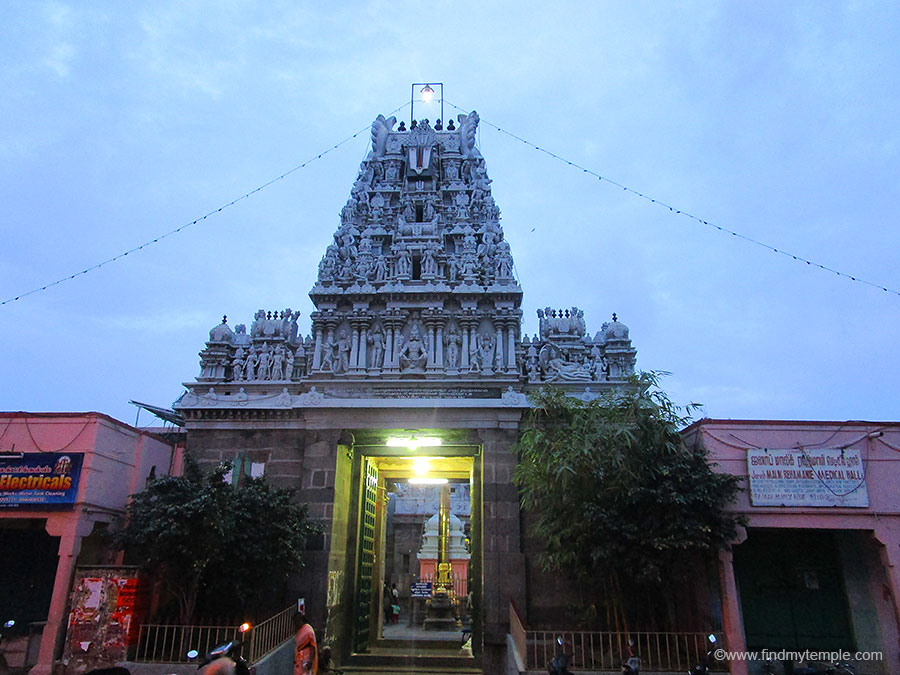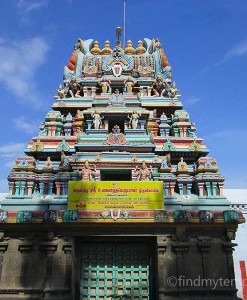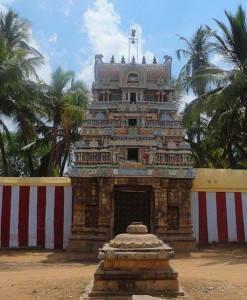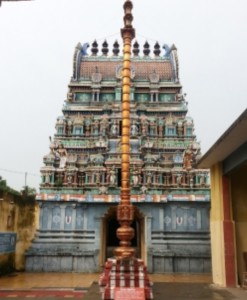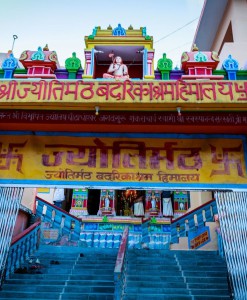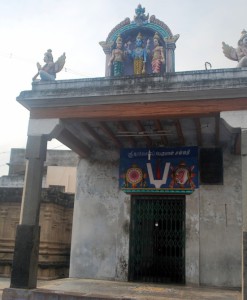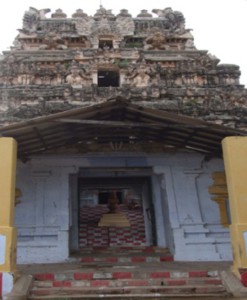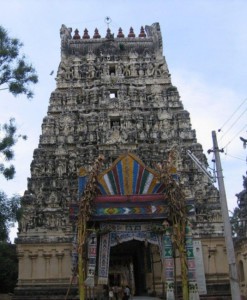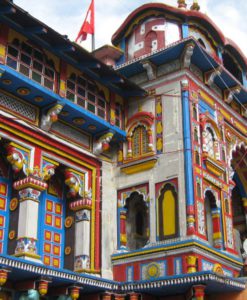No products in the cart.
The Parthasarathy Temple is an 8th century Hindu Vaishnavite temple dedicated to Lord Krishna, located at Triplicane, Chennai. The temple is glorified in the Divya Prabandha, the early medieval Tamil literature canon of the Alvar saints from the 6th–9th centuries CE and is classified as among the 108 divyadesams or holy abodes of Lord Vishnu. The name ‘Parthasarathy’, in Sanskrit, means the ‘charioteer of Arjuna’, referring to Krishna’s role as a charioteer to Arjuna in the epic Mahabaratha. It is in this battlefield that Sri Krishna gave the message of Bhagavad Gita to humanity.
Parthasarathy Temple, Triplicane, Tamil Nadu
Info on the deity – Specific to the temple deity
The Moolavar of this sthalam is Sri Venkata Krishnan. In the sanctum, he appears with wife Rukmini nearby, Mother Mahalakshmi in chest, brother Balarama at his right and Satyagi at the left, son Padyumnan and grandson Aniruddha – with his whole family. This is one of the Sthalam where the Perumal shows his seva along with his three generations. He is found in standing (Nindra thirukkolam) position and facing his Thirumugham towards East direction. This is the only Vishnu temple where Perumal appears with a moustache of a Sarathi – conducting Arjuna’s Rath in the Kurukshetra battle field. As Venkatakrishna Lord Rama grants darshan from a separate shrine with Mother Sita, Lakshmana, Bharatha, Satrugna and Sri Anjaneya.
The Parthasarathy Temple was originally built by the Pallavas in the 8th century, subsequently expanded by Cholas and later by the Vijayanagara kings in the 15th century. The temple has several inscriptions dating from the 8th century in Tamil and Telugupresumably from the period of Dantivarman, who was a Vishnu devotee. Thirumangai Alvar, the 9th century alvar also attributes the building of temple to the Pallava king. From the internal references of the temple, it appears that the temple was restored during 1564 CE when new shrines were built. In later years, endowments of villages and gardens have enriched the temple. The temple also has inscriptions about the Pallava king, Nandivarman of the 8th Century.
Venkateswara, another form of Vishnu, appeared as Parthasarathy to fulfil his promise to King Sumathi that he would give darshan to the king in this form. Sage Athreya had installed the idol of Parthasarathy. Legend has it that the parents of the Sri Vaishnava saint, Ramanuja came to the temple and prayed to the Lord for a son and eventually the saint was born. It is also believed that the Ramanuja is none other than Parthasarathy himself who was born to revive Vishishtadvaita.
According to the great Indian epic ‘Mahabharata’ ‘Partha’ meant Arjuna while sarathy is meant as charioteer. In the epic it is said during the great battle of Mahabharata Lord Krishna was the charioteer of Arjuna. In the epic Arjuna or partha was a brave warrior and Lord Krishna was a good friend, philosopher and guide to the Partha or Arjuna. Kunti (also called Pritha), Arjuna’s mother was the aunt of Krishna and the sister of Krishna’s father, Vasudeva. Krishna addressed Arjuna as Partha, the son of Pritha. Krishna was thus referred as Partha Sarthy, meaning the charioteer of Arjuna. The Bhagavat Gita is a conversation between Krishna and Arjuna taking place in the middle of the battlefield before the start of the war with armies on both sides ready to battle. Responding to Arjuna’s confusion and moral dilemma about fighting his own cousins who command a tyranny imposed on a disputed empire, Lord Krishna explains to Arjuna his duties as a warrior and prince, and elaborates on yoga, Samkhya, reincarnation, moksha, karma yoga and jnana yoga among other topics.
Krishna was neutral during the war, giving his army to Kauravas and offered himself for the Pandavas. Parthasarathy in the temple is thus depicted with a moustache and having only the conch, without his weapon Chakra. This is attributed to the promise he made to the Kauravas not to take weapons during the war. Following the traditions of a charioteer, he sported the moustache and the same is depicted in the temple. The scars in the face of Parthasarathy’s festival idol (presumably made of aimpon, an alloy of five metals) in the temple is full of scars depicted to show the injuries caused by the arrows of Bhishma in the war. The utsavar (festival deity) also has only a stick depicting Krishna was born in a cowherd clan.
According to Brahmanda Puranam, the great seven Munis (Saptha Rishis) – Brighu, Atthiri, Mareeshi, Markandeyar, Sumathi, Jaabali and Saptharomar performed Tapas (thavam) here and as a result of this, the sthalam is also called as “Brindaranyasthalam”. Also temple have been praised by two of the earliest Alwars viz. Thirumazhisai Alwar, Peyalwar and later on by Thirumangai mannan or Kaliyan, who is considered to be the last of the Alwars chronologically and his year of birth would appear to be 476 A.D. according to the era of Salivahana Saka.
Morning – Deity darshan is from 6:00 PM to 12:00 PM
Evening – Deity darshan is from 4:00 PM to 9:00 PM
Schedule:
5:30 AM – Thirumanja Kudam –(Bringing of holy water to bathe the murti )
5:55 AM -Suprabhatham
6:00 AM – First Darshan of Lord (Vishwaroopa Darshan )
6:15 AM -Offerings
8:00 AM -Kala Sandhi Theertham
11:00 AM -Noon puja
12:00 PM -Closing in the noon
4:00 PM -Evening prayers
6:00 PM -Daily evening prayer
9:00 PM -Offerings
9:00 PM -Closing prayers
In this Parthasarathy Temple Shri Bhrahma Utsav (Brahmotsavam in Chithirai (April–May), Vasanthoutsavam in Vaigasi (May–June), Shri Narasimha Swami BhrahmoUtsavam and Kodai Utsav (Summer Festival) in Aani (June–July), Shri Gajendra Motsham in Aadi (July–August), Pavithroutsavam (Thiru Pavithra Utsav) in Aavani (August–September), Navratri,Diwali are festivals celebrated here.
The most important among these festivals are the Vaikunda Ekadesi – as huge crowds from not only chennai, but also various parts of Tamil Nadu and India come to the temple on this day.
How To Reach:
By Air
Nearest Airport : Meenambakkam Airport (25 km)
By Train
The temple can be reached by the Mass rapid Transit System too and the Tiruvallikeni MRTS station is few meters away from the temple
By Road
Since the temple is in Peter’s Road, Triplicane, the heart of Chennai City the temple can be reached either by bus, auto rickshaw or call taxi. Triplicane and Vivekanandar Illam, are the nearest Bus Stand.

